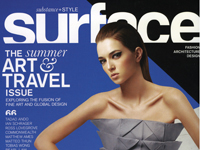
By Michael Dumiak, Shonquis Moreno, Johanna Lenander
The strange and sometimes haunting photographs of Andreas Gefeller explore the mundane magic of perspective. In his "Supervisions" series, he shows how a slight shift in view can transform our entire perception of a place, often evoking a whole new set of emotions. The photos - meticulously pieced together studies of ordinary urban spaces – become extraordinary behind his lens. These landscapes are shot slightly above ground, with Gefeller standing on a ladder, covering one square meter at a time. The pictures are then seamlessly assembled into one large scale, slightly surreal image. "I don 't alter or manipulate anything except the perspective," says Gefeller. "Everything you see in the photo is really there. It's just been documented from an impossible view."
This "impossible view" treats the onlooker to a series of quiet discoveries. What at first may seem like a beautiful abstract pattern slowly comes into focus as a place teeming with traces of human experience. "When you look at something from a distance you see a structure, but when you get closer you see individuality," says the German born artist who lives and works in his native Dusseldorf. His works depict empty urban spaces where the only signs of life are found in the stuff people have left behind. This can be litter, as in a Berlin street flooded with discarded lottery tickets, or attempts at personalization, such as in the studies of empty apartment buildings, where walls and floors have been decorated to mark an individual space.
Gefeller's distinctive technique was fueled by his fascination with maps and astronomy. "In space photography, a lot of small satellite pictures create a big picture, on a planetary level. I do the same, but on a different scale," he explains. "I feel like a satellite flying over ground, capturing detail after detail." Gefeller seems to enjoy the element of mystery that surrounds his work. "While I'm taking the picture I don't know what it will look like," he says. "It's like putting a puzzle together. Only when it's finished do I see what I photographed for the first time."